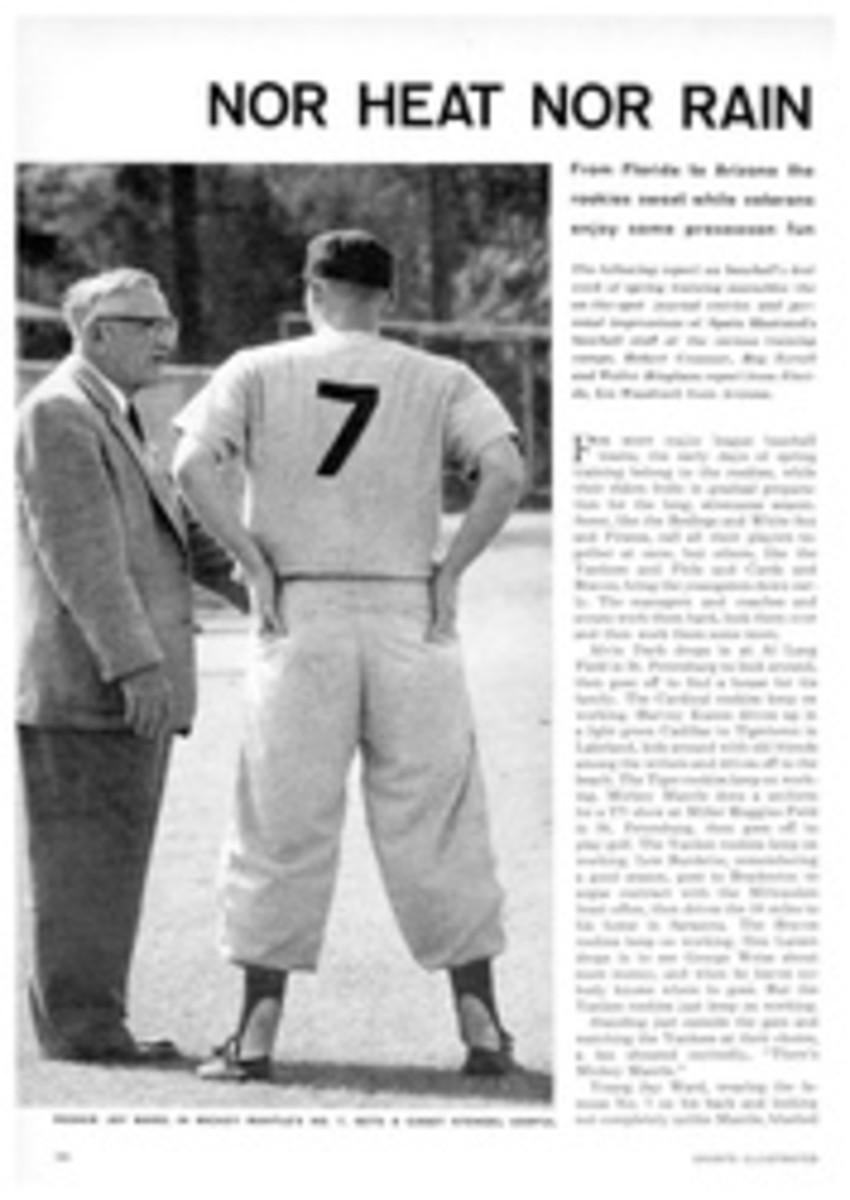
OPEN HOUSE IN OSLO
THE BIG JUMP
A supreme moment in nordic sport is shown here as a skier heads down Oslo's Holmenkollen jump toward the 100,000 watchers below.
Once a year, in the middle of winter, some 100,000 citizens of Oslo, a city of 400,000 otherwise rational souls, travel five miles out of town to stand all day in the snow, necks craned to the sky. What inspires this deep-frozen dedication is the annual running of the Holmenkollen ski jump, an immense and graceful chute that begins at a tower 130 feet high and ends at the lip of the jump, which is three stories off the ground. At the rate of five a minute, several hundred skiers hurtle down the incline, flying as far as 230 feet through the frosty air.
This year, with fog blinding the jumpers and holding the crowd down to a mere 80,000, the citizens of Oslo suffered a spiritual beating. An East German, 19-year-old Helmut Recknagel, won the special jump. Paavo Korhonen of Finland won the classic Nordic combined with the highest over-all score in jumping and cross-country. Two other rugged Finns, Olympic Champion Veikko Hakulinen (see next page) and Eero Kolehmainen, dominated the cross-country events. And when the three-day Nordic competitions were over, not one Norwegian had managed to get himself in first place. Glumly, the Norwegian hosts set about closing the hill until 1958. For at Holmenkollen, when the last leap has been leaped, the chute is closed for jumping until next winter.
During the rest of the year, visitors can admire the slide, have dinner in the restaurant just under the jump-off or visit the world's only ski museum built inside it. In the galleries are a Viking ski estimated to be 2,500 years old and hand-carved skis of the late 1880s. On hand, too, are the skis used by Mikkel Hemmestveit, who jumped 130 feet in Red Wing, Minnesota in the late 1880s and the equipment that helped Nansen explore the Arctic and Amundsen in his trek over Antarctica.
Near at hand is the Holmenkollen Hotel, first built of logs in 1894. It now has 65 rooms, 20 of them with bath, for which it charges the modest rate of $3.60 for singles and $6 for doubles. Breakfast, which in Norway could include a groaning board of cold cuts, herring, cheeses and salads, costs 80¢ U.S., and for lunch and dinner there are such Norwegian delectables as rensdyr (reindeer) schnitzel and elgbiff, which is to say, elk beef, served with fried onions, whortleberries and apples. While an ordinary steak-and-potato man from the U.S. ought to be able to handle rensdyr and elghiff as easily as a Lapp, it will take the hardiest pioneer to lap up that local gastronomic gem known as rak√ñrret, which is a trout that has been allowed to stew in its own juice until slightly rotten. It comes to the table pink and redolent, smelling like Limburger, and is dispatched with salt and pepper, flat bread and butter and aquavit, perhaps for courage.
About the same fare, plus that exported delicacy, Norwegian ptarmigan, as well as standard international dishes, are available at the Frognersetern Hovedrestaurant, perched in the Holmenkollen area, 30 minutes from town. In summer grass grows on its roofs, but summer or winter, through the plate-glass windows, the view of the city and the fiord below is magnificent, and skiers who work the slopes by day or the floodlit trails by night stop by for drinks or dinner before skiing all the way into the city. For those who don't care to use their own power, the Holmenkollen railroad runs between midtown and the hill every 10 minutes. On a good snowbound Sunday it will fetch 75,000 skiers to the nearby hills. And in Oslo, to find how the skiing is, all you have to do is dial 09 for the latest snow report.
While it is possible to live in a big city hotel in downtown Oslo and ski the Holmenkollen area, the nearest ski resort is Norefjell, three hours away by bus. The downhill and giant slalom races were held there during the Olympics of 1952 and, on Feb. 23 and 24, Norway saved some of its ancient skiing honor at Norefjell and at nearby Rodkleiva when Hans Magnus Andresen won the men's combined and Inger Bjornbakken took the women's combined in the Alpine phase of the Holmenkollen tournament.
There are two T bars in this mountain hamlet, one leading from the lake to the Fjellhvil Hotel at 2,295 feet and the other from the hotel to the top of a 4,380-foot mountain. The Fjellhvil disposes over 28 rooms, but the plumbing is down the hall. The Norefjell Hut, built for the Olympics, is bright and modern, and the dining room looks out through the glass walls to Lake Kröderen. It has 27 rooms, mostly for four, all with bunk beds. There is a rumpus room downstairs, and the place serves wine but no hard liquor. Figure $4 a day with food.
A more ambitious resort in the Swiss and Austrian pattern is Geilo (they say Yale-o) on a high plateau about midway between Bergen on the North Sea and Oslo. It is a five-hour ride from either side aboard the Bergen Railway, which is the only transport that makes the overland excursion in winter. A chair lift will take you to ski lands that stay coated into April. There are eight hotels in Geilo, of which the Holms is about the best, offering suites in Norse style, with fireplaces, for $9 a day, including everything. Easter is the peak season.
Norwegian skis with steel edges and tips and plastic running surfaces which cost about $80 in the U.S. are $35 at Marius Eriksen in Oslo. (Stein Eriksen, son of the original Marius, teaches at Heavenly Valley, Calif.) Boots, on the other hand, are mostly imported from Italy, Austria, Switzerland and Germany, and the only real buy is in a slalom shoe designed in Norway and made in Italy which costs $34 in Oslo and $50 in the U.S. Norwegian ski pants cost $11 to $23, but the best are imported from Bogner in Munich and are nearly $40 in Oslo.
Bright Norwegian sweaters with silver buttons down the front, copied all over the world, cost anywhere from $15 to $20 here in their homeland. William Schmidt at Karl Johans Gate No. 41 has about the widest selection, as well as sealskin slippers for $4; red and green felt after-ski boots for $5.50; high stockings, the current vogue in American colleges, for $5. The shelves are otherwise loaded with trolls, elves, birds carved from the molar of a sperm whale, and other necessities: Tostrup, on the same street, has been winning prizes in Italy for enameled metalware, but a vase tube 12 inches long and an inch and a half across comes to $100, and enameled flatware is $5 a piece. The Glasmagasinet, which is really a department store specializing in glass, has on display some of the most handsome glassware seen since the first postwar designs that came out of Italy.
As for what else to spend your kroner on, Norway makes dissipation difficult, since hard liquor may not be served until 3 p.m. daily, a pattern which derives from the Norwegian habit of working from 8:30 nonstop until 4 and then going home. Since neither whiskey nor aquavit is sold on Saturdays and Sundays, Saturday night in Norway is not only the loneliest but the driest night in the week.
Moorish trappings, Arab tent
Nonetheless, there is lively business on legal occasion at the bar of the Bristol, which is probably the best hotel in Oslo. And next door in the Bristol grill room a chef works over an open fire. In the labyrinth of the Bristol is a giant cave known as the Den Mauriske Hall where some 400 Norwegians can assemble at one time amid the Moorish trappings while an orchestra full of flutes and fiddles serenades under cover of an Arab tent. Diplomats and the well to do cluster in La Belle Sole, which is small and elegant and by Oslo's standards overpriced. The same set meets later in the Telle at Fridtjof Nansen's Plass No. 4. On the same premises the same owner operates a giant shed for the hoi polloi known as the Regnbuen, or Rainbow.
The rooms are cell-like in the new Viking, built by the city for the Olympics ($3 to $4 a day), but the public salons are done in brilliant Scandinavian design, particularly the dining room, which has painted wood carvings by Paul Rene Gauguin, grandson of Paul of Tahiti. The arty set assembles in the restaurant of the Continental, which is an otherwise commercial hotel, or else at the Blom on Karl Johans Gate, which is something of an inn. A fountain drips into a pool in the inner court, waiters scurry back and forth with Blom's Black Pot (chicken, beef, ham, onions and wine: $1.50), and shields dedicated to Ibsen, Vigeland, Munch and Grieg decorate the walls. They are members of the Grand Cross of the Purple Nose. Short of being so elected by Oslo's Society of Artists, which once owned the restaurant, the quickest way of attaining a purple nose in Oslo—the blue laws being what they are—is to join the crowd at the Holmenkollen watching the daring young men on the flying deep freeze.
PHOTO
DAVID MOORE
PHOTO
EERO KOLEHMAINEN, FINLAND, LED FIELD IN 50-KILOMETER CROSS-COUNTRY TEST
PHOTO
VEIKKO HAKULINEN, FINLAND, WON 15-KILOMETER, WAS SECOND IN 50-KILOMETER

